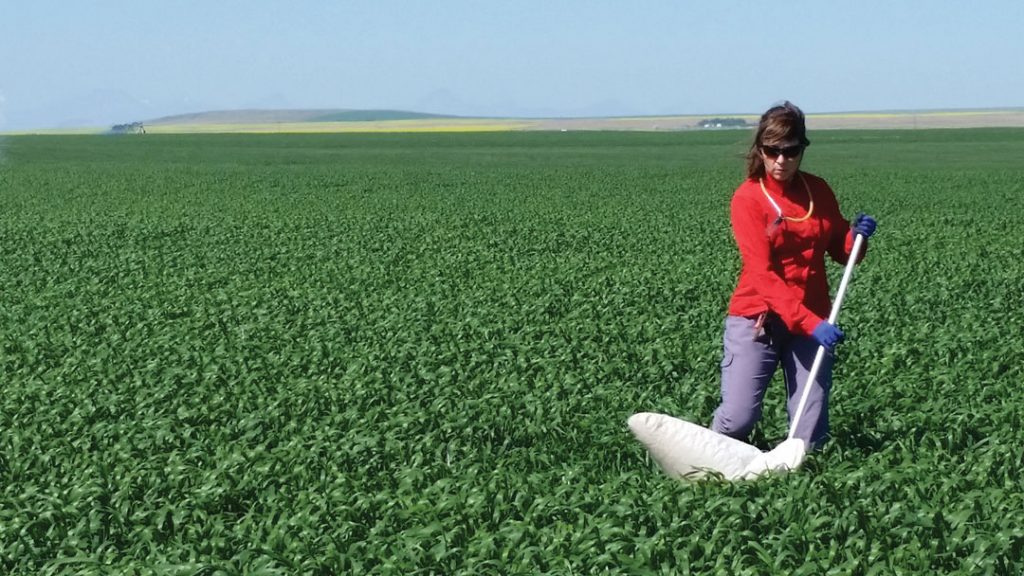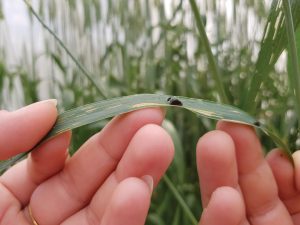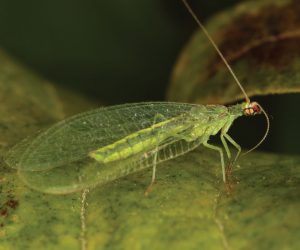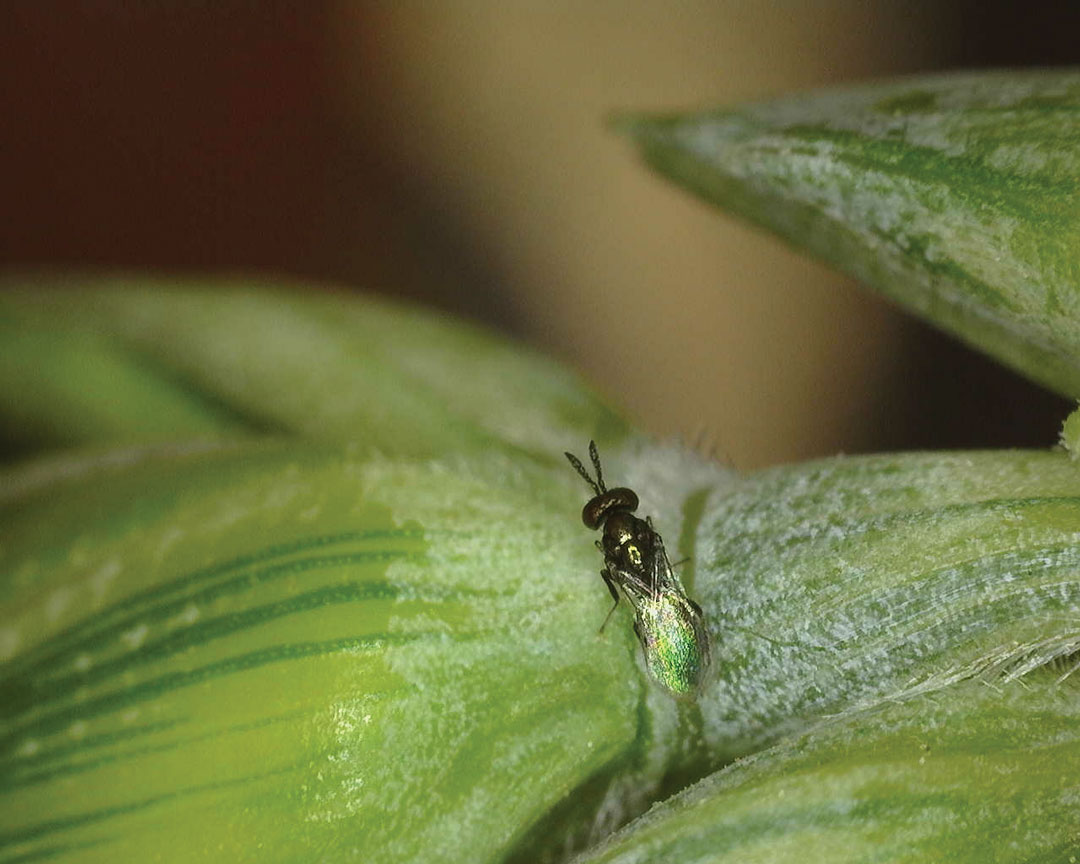FRIENDS WITH BENEFITS
BY TREVOR BACQUE • PHOTO COURTESY OF KRISTY VAVRA
Beneficial insects are old news, at least to entomologists. However, their benefits, hence the name, are in the limelight once again. This is thanks to a recent promotional campaign and the reinforcement of the notion that positive alternatives beyond blanket spraying exist.
It was eminent insect and plant scientist, professor Carl Huffaker at the University of California at Berkeley and Riverside, who in 1976 coined the phrase famous among entomologists: “When we kill a pest’s natural enemies, we inherit their work.”
This message resonates loud and clear with Haley Catton, an Agriculture and Agri-Food Canada (AAFC) entomologist stationed in Lethbridge. “It reminds us that these beneficials are just out there doing what they do, which involves eating other insects, or cycling nutrients, or just being predators,” she said. “If we wipe them out by unnecessary pesticide use, those pests bounce back, and we inherit their work.”
She said pests usually have quick lifecycles whereas beneficials are often a more delicate and complex insect. An aspect of her work that began in 2019 is the compilation of an ambitious catalogue of all Prairie bugs that consume pests and weed seeds. The project is sponsored by the Alberta Wheat Commission, Alberta Barley, SaskWheat and Alberta Agriculture and Forestry.
“Those are ecosystem services for free,” she explained. “If we were to lose those services, we would have to pay for them with increased chemical usage. The services they are providing have value, but how much value? If we could demonstrate how much value these insects are providing in their field it would create more incentive for farmers to be judicious with pesticide use.” While Catton does not object to insecticide use when it is necessary, she is using science to show the hidden costs of unnecessary application.
The factor that determines when spraying should occur is the economic threshold. It is critical to understand this and utilize it properly in a given field. A farmer who may spray for aphids will be able to adequately control the population but may unintentionally end up killing beneficials that control other pests such as cutworms. “There’s a whole cascade of effects, which is why economic thresholds are important,” she said.
Her catalogue will also include a calendar detailing which beneficials are active at what time of year. About 80 ground beetle species alone inhabit the average Prairie field. Each has its own lifecycle and it’s important to understand when certain beetles thrive. The giant beneficial insects research road map is her ultimate goal to help direct efforts on specific insect-related work in the future.
A major motivation for Catton, as well, has been the work of the Western Grain Research Foundation’s promotional campaign, Field Heroes. She said the program, which began in 2018, has helped reignite positive conversation around the overall benefits of beneficials.
Aside from identifying and better understanding beneficials, Catton aims to eventually ascribe dollar amounts to their worth, something very difficult to manage with accuracy. She said some days the work makes her feel like a horse racing bookie.

“No one can predict the exact future. I can’t guarantee the winner, but I feel like my role as a scientist is to help farmers make an informed decision, in other words determine the odds of a situation working out in their favour,” she said. “The goal is to be able to say to farmers: ‘this many beneficials are worth this much money.’ Then the farmers can decide how to bet given those odds. In terms of influencing management, the more accurate the odds, the better the bets farmers can make. To apply insecticide or not is their final decision to make. It is their money on the line, and they need the best information possible to make those kinds of decisions.”
But the value certainly is difficult to quantify. A 2017 study by Michigan State University determined the simple presence of certain beneficials such as spiders and lady beetles can cause pests to consume less. Despite a lack of robust beneficial data, limited studies have successfully quantified the information with hard data. A 2009 economic impact study by Owen Olfert calculated that the use of $248 million worth of insecticide was made unnecessary by the work of Macroglenes penetrans, the beneficial insect that kills orange blossom wheat midge.
Another more recent finding is the brutal efficiency of the almost invisible predator wasp Tetrastichus julis, which kills cereal leaf beetle by laying eggs inside of the destructive insect. T. julis provides certain Prairie fields between 50 and 90 per cent control. “We think that T. julis is the reason why cereal leaf beetle did not explode on the Prairies,” she said. “People rarely have to spray for cereal leaf beetle here.”
Catton’s national colleague on the project, Tyler Wist, is also an AAFC entomologist based in Saskatoon, SK. He also knows the value of beneficials and wants to share this knowledge with the world. The primary focus of his beneficial insect research involves identifying the predators of aphids in cereal and pulse crops to determine if they affect control of aphid populations. He also studies the parasitoids of the wheat midge and is looking into possible predators of flea beetles in canola through a multi-researcher, multi-province project.

Wist said it is not a simple task to calculate the economic value of beneficials, but this does not mean it’s impossible. “You have to know at what point the insects damage the crop and when you need to take action,” he said.
However, Wist cautions that farmers should be certain they are going to suffer an economic loss before spraying because of the potential untold damage that could occur to beneficial insects that roam farm fields.
For instance, a number of insecticidal sprays are broad spectrum and will certainly work to kill the pest at hand, but will also kill beneficials. Certain sprays make the ground toxic to ground beetles for up to seven days post-application. The toxicity destroys the brain receptors that control a beetle’s basic motor functions.
“Those beneficials, if they get there in time, they can suppress pests from reaching that economic threshold,” he said. “If the crop is not at that threshold, it’s not taking that loss. Otherwise, you take that loss pulling out the sprayer, diesel, chemical and your time to spray.”
One of the key things to remember, Wist said, is that many of the beneficial insects, such as ground beetles, are nocturnal and will virtually never be seen, as they hunt at night. For every pest, there are usually two to three corresponding beneficials, and identification is critical in order to fight pests in an informed manner.
“Ladybug larvae is kind of frightening looking and can cause a farmer to say, ‘what should I be treating them with?’” he noted as an example. “Farmers need to remember that not everything in your field is going to be a pest.”
There’s an app for that
A trove of insect resources that can be accessed through apps or found online. Catton and Wist recommend the
following resources for farmers who want to get smart on beneficial bugs. Apps are available from Google Play and the Apple Store where noted.
xarvio Scouting app: Assess leaf damage from pests as well as weeds and diseases. The app can determine exactly the percentage of a given leaf that has been damaged, which can help determine if spraying thresholds have been triggered. Google Play and Apple Store
Cereal Aphid Manager app: A straightforward app from the federal government, CAM gives farmers aphid and aphid predator scouting information on barley, oat, rye and wheat and predicts what the aphid population will be in one week’s time. It indicates when insecticidal control is necessary, using dynamic action thresholds that take into account the actions of beneficial insects on aphid populations. Google Play and Apple Store
Aphid Advisor app: A soybean specific app, it can suggest the appropriate time to spray if soybean aphids require control. To help make the determination, the app utilizes aphid and natural enemy numbers and extrapolated growth rates. The app’s recommendations become more refined as more user data is submitted. Google Play and Apple Store
iNaturalist app: While not specific to agriculture, this app is like Facebook for nature lovers and can suggest the identity of insects from submitted pictures. A project of the National Geographic Society and the California Academy of Sciences, this amazing user-driven app catalogues the time, location, date and other user submitted details about insect finds. Citizen scientists can then discuss findings in online forums. More than 56 million images have been submitted representing more than 313,000 species. Google Play and Apple Store
Field Heroes: The brainchild of the Western Grains Research Foundation, Field Heroes is a social media platform that assists Canadian farmers in the identification of helpful and harmful insects. Its motto is “Think beneficials before you spray,” and it features the bedrock resources farmers need to identify pests, understand beneficials and scout for either. Find Field Heroes on Twitter @fieldheroes or online at fieldheroes.ca.
Government of Canada field guide: An annually updated PDF that
addresses issues and features management tips on more than 90 pests in Western Canada. It also includes information on more than 30 beneficial insects that kill various pests. Go to canada.ca and search “Field crop and forage pests and their natural enemies in Western Canada: identification and management.”
Who’s who?
Now that you know a thing or two about beneficial insects, what on earth do these insects look like? Wonder no more. Below are common Prairie beneficials you may have seen or perhaps you’ve witnessed evidence of their diligent work terminating true pests.
Parasitic wasps:
Parasitic wasps are some of the tiniest and most impressive beneficial insects out there. Small and stealthy, they are easily missed by the untrained eye. But they are big players in providing free pest control. Here are three of the main wasps buzzing around Prairie crops.
Bracon cephi focuses specifically on wheat stem sawfly, which has been a longtime issue for Prairie farmers. Only a few millimetres in length, this wasp lays its eggs in stems infested with wheat stem sawfly. In an invisible showdown inside the stem, the B. cephi larva hatch, eat and kill the sawfly larva, protecting yield. The wasp larva then transforms into an adult in the stem, starting a new generation. The only trace of this beneficial insect’s
presence is the tiny exit hole it makes as it leaves the stem.
Macroglenes penetrans (see photo on page 24 ) is the main parasitoid of the orange blossom wheat midge, Sitodiplosis mosellana. This wasp kills an average of more than 30 per cent of overwintering cocoons of the wheat midge by laying its eggs directly inside the midge. In springtime it bursts through its host, killing it instantly. Annually, this helpful insect saves farmers millions of dollars on input costs.

Tetrastichus julis is a seriously beneficial insect. Adult females lay their eggs inside the larvae of cereal leaf beetle. The wasp larvae hatch and eat the beetle larvae from the inside out, preventing the pest from completing its life cycle. Half or more cereal leaf beetles in a field may be parasitized by T. julis. This pipsqueak of a beneficial has likely prevented the outbreak of cereal leaf beetle as a more serious pest in Western Canada.
Damsel bug: The common damsel bug, Nabis americoferous, has semi-raptorial front legs for grabbing prey. It stabs its “beak” into its prey, injects a digestive enzyme then sucks out the digested insect insides. Cool, gross and true all at the same time.
Ground beetle: Poecilus lucublandus is one of the most common ground beetles on Prairie farms. While it is mostly a predator, like most carabids, it is also an omnivore and will eat weed seeds and whatever else it may encounter.

Common green lacewing: Chrysoperla carnea in its larval stage is aptly called an aphid lion for the voracious way it attacks its prey. Ever hungry, green lacewing larvae can eat about 33 aphids daily. A green lacewing larva also has an appetite for thrips, mites and certain caterpillars. The larva’s front mandibles make an
excellent set of grabbers to pull in yummy pests.

Lady beetles: The Coccinella septempunctata is perhaps the most well-known beneficial insect because it is cute and often appears in children’s storybooks . A lady beetle is easily identified by its seven spots and its love of munching on aphids. Even as they mature, they are great hunters and in their larval stage they almost resemble little alligators. These colourful beneficials may eat up to 5,000 aphids in their lifetime.
Painted lady butterfly: Cheerful, majestic and full of grace, this butterfly is also a vicious killer known in Latin as Vanessa cardui. Sometimes good and sometimes bad, the beneficial aspect of a painted lady butterfly is the rapacious appetite of its larvae for Canada thistle. Its larvae also enjoy feeding on soybeans and sunflowers. Downsides include leaving its frass, or poop, behind on canola blooms, which can result in downgrades upon delivery.
Hoverfly: Sometimes called a syrphid, hoverflies are abundant in Canada. A person could be forgiven for thinking they are a wasp, despite their lack of a stinger. They lay eggs directly into aphid colonies and, from birth, the larvae start eating aphids. It happens quick and the hoverfly has perfected this deadly operation.







Comments